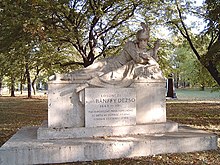Dezső Bánffy
Baron Dezső (Desiderius) Bánffy of Losonc (* 28. October 1843 in Cluj , then Kingdom of Hungary ; † 24. May 1911 in Budapest ) was the Prime Minister of Hungary from 1895 to 1899, a leading politician in Austria-Hungary .
Life
Dezső was the son of Dániel Bánffy (1812-1886), a baron with only "modest property" and his wife Anna Gyárfás (1821-1902). He studied at the universities of Berlin and Leipzig . From 1875 he was chief clan in several Transylvanian counties . There he campaigned for the Magyarization of the country, which is why he was given the name " Dobokaer Pascha" by his own compatriots .
He became President of the Hungarian Reichstag in 1891 as a member of the Liberal Party . At the funeral of the national hero Lajos Kossuth, he outraged public opinion with his demonstrative absence.
Prime Minister
Than 15 January 1895 surprisingly from the king appointed Prime Minister , he led against fierce opposition from the Catholic Church and the Catholic People's Party , a canon law reform through. He was also initially successful in the regular balancing negotiations with Austria in 1897 .
He institutionalized and bureaucratized the nationality policy, combined with reprisals for the minorities in the kingdom. Bánffy raised the idea of the Hungarian nation-state to the government program: "The nation-state should be realized through the Magyarization of place names, family names and through intensive language lessons". For him, the language dispute with the minorities was just a pretext: "The question of language is only a means, the real goal is to introduce a federalist policy in Hungary". His government is described in research as intolerant, chauvinist and repressive.

The policy of Magyarization pursued by his predecessors since Kálmán Tisza , which was particularly successful among the Slovak and German populations of Transleithania , caused the Magyar population to grow to just over half. Between 1880 and 1910 the percentage of citizens of Hungary (excluding Croatia ) professing to be Magyars rose from 44.9 to 54.6%. With the help of the reactionary right to vote, which only allowed the privileged part of the population to vote - in 1913 only 7.7% of the total population were eligible to vote (or were allowed to hold public offices) - the reactionary structure of the multi-ethnic state of Hungary was cemented.
On May 16, 1895, Bánffy forced the resignation of Foreign Minister Gustav Kálnoky because he considered his Balkan policy towards Russia to be too weak. For trade unionists and social democrats , too , his authoritarian reign was “a time of restrictions and harassment”.
At the beginning of 1899 the growing disputes with the parliamentary opposition culminated in a duel between Bánffy and his fiercest opponent Nándor Horánszky. On February 26, 1899, Bánffy resigned as head of government.
Fonts
- A magyar nemzetiségi politika. Légrády Testvérek, Budapest 1903 (German: The Hungarian Nationality Policy).
literature
- Bánffy, Dezsö, Baron . In: Encyclopædia Britannica . 11th edition. tape 3 : Austria - Bisectrix . London 1910, p. 315 (English, full text [ Wikisource ]).
Web links
Individual evidence
- ↑ a b Zoltán Horváth (Ed.): The turn of the century in Hungary. History of the second generation of reforms (1896–1914). Corvina, Budapest 1966, p. 171.
- ↑ Gerald Volkmer: The Transylvanian Question 1878-1900. The influence of the Romanian national movement on diplomatic relations between Austria-Hungary and Romania. Böhlau, Cologne / Vienna 2004, ISBN 3-412-04704-X , p. 229.
- ↑ a b Bánffy Desider Baron. In: Austrian Biographical Lexicon 1815–1950 (ÖBL). Volume 1, Verlag der Österreichischen Akademie der Wissenschaften, Vienna 1957, p. 48.
-
^ Adjustment crisis of the Saxon and Romanian national movement
Gerald Volkmer: The Transylvanian Question 1878-1900. The influence of the Romanian national movement on diplomatic relations between Austria-Hungary and Romania. Böhlau, Cologne / Vienna 2004, ISBN 3-412-04704-X , p. 229. - ↑ Ákos Moravánszky: The architecture of the turn of the century in Hungary and its relationship to the Viennese architecture of the time. Vienna 1983, ISBN 3-85369-537-X , p. 48.
- ^ Zoltán Horváth (ed.): The turn of the century in Hungary. History of the second generation of reforms (1896–1914). Corvina, Budapest 1966, p. 55.
- ^ Robert Bideleux, Ian Jeffries: A history of Eastern Europe. Crisis and change. Routledge, London 1998, ISBN 0-415-16111-8 , p. 259.
- ↑ Wolfdieter Bihl : The way to collapse. Austria-Hungary under Karl I. (IV.) In: Erika Weinzierl , Kurt Skalnik (Ed.): Austria 1918–1938. History of the First Republic. Graz / Vienna / Cologne 1983, Volume 1, ISBN 3-222-11456-0 , pp. 27–54, here p. 44.
- ^ Mathias Bernath (ed.): Biographical Lexicon for the History of Southeast Europe. Volume 1, Verlag Oldenbourg, Munich 1972, ISBN 3-486-47511-8 , p. 330.
-
^ Tibor Süle: Social Democracy in Hungary. On the role of the intelligentsia in the labor movement, 1899–1910. Böhlau, Cologne / Graz 1967, p. 32.
The Danube region. Journal of the Institute for the Danube Region and Central Europe 22 (1977), ISSN 0012-5415 , p. 29.
| personal data | |
|---|---|
| SURNAME | Bánffy, Dezső |
| ALTERNATIVE NAMES | Losonczi báró Bánffy Dezső |
| BRIEF DESCRIPTION | Austro-Hungarian politician |
| DATE OF BIRTH | October 28, 1843 |
| PLACE OF BIRTH | Cluj-Napoca |
| DATE OF DEATH | May 24, 1911 |
| Place of death | Budapest |

